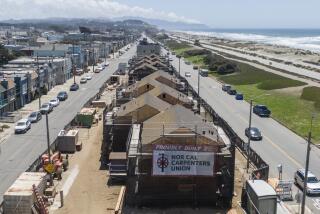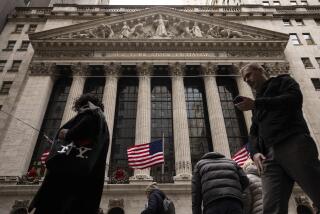Modest Growth Will Continue, UCLA Predicts : Declining Interest Rates Also Forecast for 1986
- Share via
The modest growth and declining interest rates that characterized the local and national economies in 1985 will continue through next year, but so will worries about the federal budget deficit and its potential to create double-digit inflation by decade’s end, forecasters at UCLA predicted Wednesday.
Growth in California will continue to outpace the nation’s, the forecasters said, with personal income rising 7.1%--just slightly ahead of the national rate.
Aerospace employment will grow 3.1%, about the same as this year. But it will “return to vigorous growth by 1987 and 1988, rising about 7% each of those years,” the forecast said. Growth in the trade and service industries will continue in the 4% to 5% range next year but will jump to 6% in 1987 and 1988.
Optimistic Outlook
“We think the outlook for 1986 is optimistic and realistic,” said Larry Kimbell, director of the UCLA Business Forecasting Project, which held its 34th annual forecasting conference Wednesday. “But this is a cop-out economy,” he said, referring to the forecasters’ assumption that Congress is unlikely to cut the deficit.
If Congress takes no action, the deficit, which has reached a record $189 billion this year, is likely to drop to $155 billion in 1986 because of market forces and to continue to decline in 1987 and 1988, the forecast said. But the drop may not be deep or swift enough, Kimbell said, and could result in an inflation rate of 9% or more by 1990.
The UCLA forecast predicts, however, that next year the consumer price index will increase only 3.6%. The index, a widely used measure of inflation, grew 3.4% in 1985 and 4.3% in 1984. The forecast also predicts that the gross national product will increase 3.2% in 1986, compared to 2.7% in 1985 and 6.8% in 1984.
Should Congress “surprise us with more substantial budget cuts,” inflation could drop to 3% or less annually for several years, Kimbell said. That would ensure a continued decline in interest rates, which in turn would weaken the dollar, making domestic goods less expensive to foreigners and so helping to narrow the foreign trade deficit.
Benefited by Inflation
Kimbell said that, in the meantime, the Federal Reserve Board, which has no control over the deficit, is making sure there is enough money in the economy to fuel growth rather than curbing the money supply to try to reduce inflation.
Some sectors of the economy that benefited by accelerating inflation actually would welcome a return to rising rates. In any case, Kimbell said, the runaway inflation of the late 1970s raised the level of inflation many economists find acceptable.
“Some economists view 4% inflation as quite high, and certainly it would have seemed so in the early 1960s,” the published forecast says. “But ‘low inflation’ to many today means 3% to 4%, and no great alarm is encountered from projections that inflation might rise to annual rates of 5% to 6%.”
More to Read
Inside the business of entertainment
The Wide Shot brings you news, analysis and insights on everything from streaming wars to production — and what it all means for the future.
You may occasionally receive promotional content from the Los Angeles Times.










